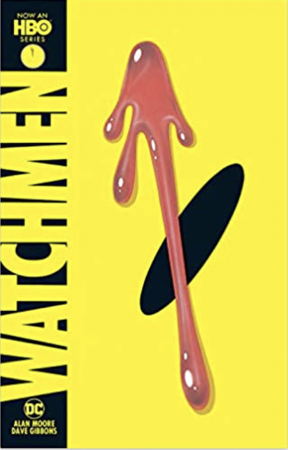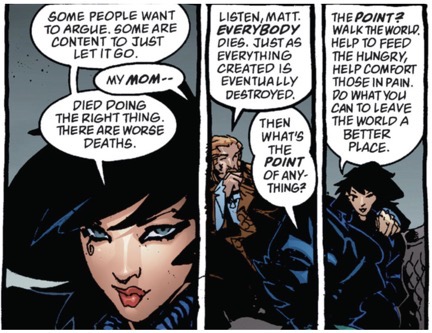It can be deeper than you might think.
When I was a kid, I glazed over the comic book phase a lot of kids go through. I don’t think I read more than 10 of them. They just weren’t interesting to me. I preferred regular books.

I read The Watchmen at least 15 years ago.
So it’s understandable that I wouldn’t be too interested in graphic novels. In fact, I didn’t know much at all about the genre until years and years ago when I read The Watchmen. This is before it was made into a TV show on HBO (which I still haven’t seen; I’m not an HBO subscriber). It struck me as interesting, but I didn’t really get much out of it. Maybe because I was reading it the way I read books? Fast to get through the story?
I’m older now and I’m more interested in expanding my horizons. That includes what I read. I generally don’t enjoy the latest bestselling literary fiction; I find it dull: too many long, meandering stories that have no satisfying end. The Goldfinch, although beautifully written, was like that. I read a lot of action fiction (think Jack Reacher and Jack Ryan) and mystery fiction (think Dorothy Sayers, Raymond Chandler, and yes, even some Agatha Christie). I’ll read one book by an author and, if I like it, read five more. (That’s what ruined Robert Ludlum’s work for me: his plots are so totally formulaic, which is obvious when you read five of his books in a row.) I also read Star Wars fiction beyond the movies and television shows. I didn’t realize until a few years ago that there are scores of books in the canon and many more that were written before there was a canon.

Anyway, I was reading a book of Neil Gaiman’s essays, The View from the Cheap Seats, and was enjoying the way it made me stop and think about things I’d never really thought about before. I’d read some of Gaiman’s fiction — Coraline, The Graveyard Book, American Gods, The Ocean at the End of the Lane — heck, I didn’t realize I’d read so much of his work until I drew up this little list — but had little knowledge of his graphic novels. But the Sandman series, which is apparently his magnum opus in that genre, was mentioned in one of the essays and I decided to check it out.
I’ll be the first to admit that I avoid buying books these days. It’s embarrassing for a writer to admit, but there it is. I simply read too fast to invest in a book I’m likely to read just once. I’m. not saying I don’t buy books at all — unfortunately, I do. I buy too many books. I have hundreds of books at home, some of which I never even bothered to unpack after my 2013 move from Arizona to Washington. This year, 2022, is the year that I will begin to liquidate my library. (I need to downsize for an upcoming lifestyle change anyway.)
Instead, I use the library where I get books in two formats: ebooks and audio books. I read ebooks in the morning with my coffee and sometimes in the evening before I go to bed. I read audio books while I’m driving or working on jewelry projects in my shop. It’s not unusual for me to be reading two very different kinds of books at the same time. (I’m extremely fond of Random House productions of Star Wars books. Great narrators who voice each character individually and sound effects/music that really dramatize the work.)

I tracked down The Sandman Volume 1 at my library using the Overdrive app and put it on hold. A week later, it was available and I was able to read it on my iPad using a web browser.
I absolutely loved the art that started each chapter in the edition I was reading (which may differ from the edition I linked to above), but really did not like the actual art within the book. But I looked past that and read the story. Or at least tried to. My brain was not accustomed to reading the graphic novel format. I often read things in the wrong order. I found myself missing things because I was too focused on words and not focused enough on the story told in the images that went with them. I got the main gist of the story and enough details to enjoy it — despite the gruesome violence in some parts. But, at the same time, I wasn’t much interested in trying Volume 2 (which my library does not have anyway), especially if the same artists illustrated it in the same style.

The last story in Volume 1 introduced the Sandman’s sister, Death. On a whim, I decided to give Death: The High Cost of Living a try. It was available in my library in a Kindle-compatible format, which turned out to be great for me. This format didn’t show a page at a time unless that’s what you wanted to see. Instead, it used a zoomed in technique to show one or more frames at a time. I’d swipe to expose more frames or zoom to the next frame. It made it impossible for me to read text in the wrong order and it magnified the content so that it was easier for my old eyes to read and enjoy.

Death is portrayed as an attractive goth chick.
I’ll start off by saying that the book is dark. The main character, Death, is portrayed as a friendly, attractive goth girl/woman. (Older than a girl but somehow younger than what you might think as a woman.) The people she meets with in most stories are people who are contemplating suicide or will die shortly or have died or are facing the death of someone else. So the main theme that is explored in various ways is death itself.
As I read, I worried over and over about young people who are contemplating suicide reading this book and thinking its okay. But that’s not the message that comes from it at all.
The book is really about life. That life isn’t always easy. That we make our own lives. That we have to take the bad with the good because the bad helps us see how good the good really is.
The first piece of dialog that really hit me hard is something that I’ve always believed and try so hard to tell other people — especially young people:
… Let me tell you what you get. You get life and breath, a world to walk and a path through the world — and the free will to wander the world as you choose.

Death and Destiny share some good advice with a suicidal teen.
This was said by Death’s brother — I think it was Destiny, although his name was never mentioned — to a teenage boy who had climbed to the top of a Ferris wheel one night to kill himself. He’s depressed because his mom died at the World Trade Center and he blames God for letting it happen. He wants to die so he can ask God why he let it happen. Destiny tells him that God doesn’t answer questions. Later, Death joins them in the panels shown here.
This book is full of stuff like this.
Anyway, I’m enjoying this book a lot more than The Sandman. Part of it is the artwork. Another part is the clear messages it’s sending about life and death.
It’s a quick read for me, especially since I don’t linger much over the artwork. I’m nearly done. But it was on my mind this morning so I thought I’d blog about it.
My Twitter friend Juliana mentioned today how re-reading books at different times of her life bring out different aspects of the books. (I’m paraphrasing a conversation here.) I think she’s right.
I think it’s time to read The Watchmen again, just to see what I missed the first time around.
Discover more from An Eclectic Mind
Subscribe to get the latest posts sent to your email.

I’m pleased that you are getting inspiration from Gaiman.
I have no time for fiction these days, reality is so much stranger and more involving. Primo Levi’s writing is staggering in its power. ‘If this is a Man’ and the ‘Periodic Table’ take us back to his time in Auschwitz. Every word true.
If I need to be reminded about the brevity of life I read the poems of John Keats. Ode to a Nightingale is a timeless delight, simultaneously profound and beautiful.
The same goes for film. The Dambusters (true story) has more drama than a thousand hours of samey sci-if.
After spending years just reading nonfiction, I am enjoying the escape back into fiction. I simply don’t want to be reminded of reality these days.
Of all the pieces you’ve listed, the only one I know firsthand is Dambusters, which was a great movie that I saw many years ago.
Give Keats a chance. I would really like to know your reaction.
When he wrote that poem he was dying of TB, caught as a medical student. The poem is over 200 years old yet it still has relevance for me.
Glad you liked Dambusters. Gibson was shot down over Holland a year later and his grave is still tended by the Dutch and visiting Brits.
I’m embarrassed to say this, but I really don’t like poetry.
Already with thee,
Tender is the night.